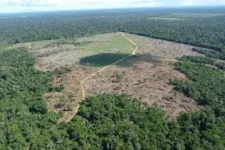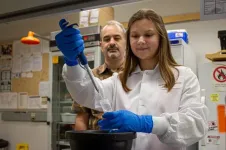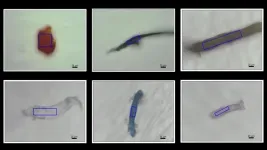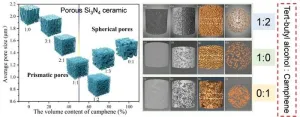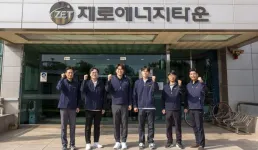(Press-News.org) Brazilian Legal Amazonia (BLA) – which comprises the entirety of the Amazon Basin located in Brazil and vast adjacent swathes of the Cerrado, spanning nine states – is more than 5 million square kilometers (km2) in area and corresponds to almost 60% of the country’s land mass. Almost a quarter of this area (23%) has been deforested, and over 1 million km2 are degraded, so that the region risks reaching an ecological tipping point at which ecosystems collapse and billions of tons of carbon are released into the atmosphere. Some parts of BLA, especially borderlands of the Cerrado and the so-called “Deforestation Arc”, are now net carbon emitters. Conservation of the virgin forest areas and rehabilitation of degraded areas are urgently needed, and members of the global community are taking action in this regard.
Foreign demand for commodities is often considered the main driver of deforestation. It is certainly significant, but domestic markets exert far greater pressure, according to a study by Eduardo Haddad and collaborators published in the journal Nature Sustainability.
“Deforestation is often evaluated from the supply standpoint, meaning the analysis focuses on the productive sectors that are promoting replacement of forest by other land uses, such as growing of crops and raising of livestock. The methodology we used enabled us to see the phenomenon of deforestation from the demand perspective as well, identifying the sources of the economic stimuli that get productive sectors involved in deforestation. Based on this criterion, our study shows that 83.17% of deforestation was driven by demand from outside Amazonia and only 16.83% by demand from the region. Breaking down that 83.17%, we found that demand from other parts of Brazil accounted for 59.68% and foreign demand for 23.49%,” Haddad said.
Haddad is full professor at the University of São Paulo’s School of Economics, Administration, Accounting and Actuarial Science (FEA-USP), and a consultant to multilateral development finance organizations such as the World Bank, Inter American Development Bank (IDB), Organization for Economic Cooperation and Development (OECD), United Nations Development Program (UNDP) and Joint Africa Institute (JAI).
The methodology used in the study was based mainly on the input-output matrix model developed by Russian-born American economist Wassily Leontief (1906-1999). The model represents the relations among economic sectors as a matrix, showing how inputs in one industry produce outputs for consumption or for use as inputs by another industry, and how changes in production of goods or services affect demand for inputs.
“In Brazil, the most recent input-output matrix was produced by IBGE [the national statistics bureau] in 2015. It hasn’t been updated since then, owing to mathematical complexity and restricted access to data for millions of companies and their business structures. Using data for 2015 would be inadequate if not for the unfortunate fact that the structure of the Brazilian economy has changed very little in the meantime.
The 2010s were the worst decade for GDP in the 120-year time series, with growth of only 0.3% per year on average. We used the 2015 input-output matrix adapted for BLA, combined with sectoral and regional deforestation data and greenhouse gas emissions, to measure the direct and indirect impact of domestic and foreign demand for BLA’s inputs and outputs, focusing on deforestation-intensive sectors such as agriculture,” Haddad explained.
Land-use changes
The Amazon has undergone enormous changes in the last half-century. Technical innovations, investment in infrastructure and political changes have facilitated the expansion of soybean farming from the central Cerrado to vast portions of BLA. Local production of soybeans, which was less than 200 metric tons in 1974, or a mere 0.02% of the national total, reached 50 million mt in 2022, accounting for 41.5% of the total. Livestock farming has expanded just as vertiginously, from 8.9 million head of cattle in 1974 (9.5% of the national total) to 104.3 million in 2022 (44.5% of the total).
“The expansion of cattle ranching was driven mainly by growth in consumption of beef, dairy and leather goods in other parts of Brazil. In line with the rise in per capita income and rapid urbanization, meat consumption rose faster than the world average after the 1960s. Of the 1.4 million hectares deforested to make way for cattle pasture, 61.63% responded directly or indirectly to domestic demand from outside the Amazon and 21.06% to foreign demand. Deforestation to make way for crops displayed a different pattern, with 58.38% responding to demand for exports and 41.62% to domestic demand,” Haddad said.
The article on the study in Nature Sustainability notes that deforestation in Brazil has been concentrated geographically in BLA, affecting different biomes. In 2015, BLA accounted for 65.7% of total deforestation nationwide. Cattle ranching was the main immediate cause (with 93.4% of the regional total), followed by farming of crops, mainly soybeans, corn and cotton (6.4%), and mining (0.2%). Construction of infrastructure and intensive urbanization were among the anthropic drivers directly linked to the elimination or degradation of the original plant cover in the Amazon Rainforest and Cerrado biomes.
“Illegal activities such as grilagem [misappropriation of government land via falsification of title deeds] are highly relevant in this context. A recent study shows that half of all the deforestation seen in BLA in the last two decades took place on government land illegally occupied by grileiros. Litigation over land ownership lasts decades and doesn’t prevent most illegal areas or illegal deforestation on private property from participating in both the market for land and the production process,” Haddad said.
This latest study by Haddad et al. shows that economic demand from Brazil’s most developed regions (Southeast, Center-West and South) is an even stronger driver of deforestation in the Amazon than the export market. This finding is an important contribution to policymaking and action by civil society to conserve or regenerate such areas. Moreover, because land-use changes via cattle ranching and monoculture are still the main sources of CO2 emissions in Brazil, control of deforestation and degradation is imperative if Brazil is to achieve its greenhouse gas emission reduction targets.
Haddad is the corresponding author of the article, whose last author is Carlos Afonso Nobre. The other co-authors are Inácio Fernandes de Araújo Junior, Rafael Feltran Barbieri, Fernando Salgueiro Perobelli, Ademir Rocha, and Karina Simone Sass.
FAPESP supported the study via two projects (14/50848-9 and 21/12397-9).
About São Paulo Research Foundation (FAPESP)
The São Paulo Research Foundation (FAPESP) is a public institution with the mission of supporting scientific research in all fields of knowledge by awarding scholarships, fellowships and grants to investigators linked with higher education and research institutions in the State of São Paulo, Brazil. FAPESP is aware that the very best research can only be done by working with the best researchers internationally. Therefore, it has established partnerships with funding agencies, higher education, private companies, and research organizations in other countries known for the quality of their research and has been encouraging scientists funded by its grants to further develop their international collaboration. You can learn more about FAPESP at www.fapesp.br/en and visit FAPESP news agency at www.agencia.fapesp.br/en to keep updated with the latest scientific breakthroughs FAPESP helps achieve through its many programs, awards and research centers. You may also subscribe to FAPESP news agency at http://agencia.fapesp.br/subscribe.
END
Deforestation in the Amazon is driven more by domestic demand than by the export market
A study by the University of São Paulo shows that expansion of cattle ranching to meet growing domestic demand has contributed more than any other driver to the elimination or degradation of the Amazon’s original vegetation
2024-09-20
ELSE PRESS RELEASES FROM THIS DATE:
Demand-side actions could help construction sector deliver on net-zero targets
2024-09-20
Using state-of-the-art energy efficiency technologies to renovate existing properties and construct new ones could enable Europe’s construction sector to almost eliminate its carbon emissions by 2060, a new study suggests.
Published in the journal Renewable and Sustainable Energy Reviews, the research is the first to fully assess the potential for energy demand reduction across the construction sectors of the United Kingdom and all European Union member states.
It highlights that 75% of Europe’s building stock is currently classed as energy inefficient, with total floor space also ...
Research team discovers molecular mechanism for a bacterial infection
2024-09-20
Virginia Tech researchers have learned how bacteria manipulate molecules to infect the host organism.
Daniel Capelluto and his research team have discovered the mechanism by which the bacterial pathogen Shigella flexneri, the causative agent of dysentery, manipulates molecular activity to assure its survival against its host’s natural defenses. Their findings were recently published in Structure, a Cell Press journal that supports open access.
“This infection strategy may be employed by other bacteria, making this research a potential foundation for understanding the molecular mechanisms underlying various bacterial infections,” said Capelluto, associate professor ...
What role does a tailwind play in cycling’s ‘Everesting’?
2024-09-20
WASHINGTON, Sept. 20, 2024 – Within the cycling realm, “to Everest” involves riding up and down the same mountain until your ascents total the elevation of Mt. Everest — 8,848 meters.
After a new cycling “Everesting” record was set a few years ago, a debate ensued on social media about the strong tailwind the cyclist had on climbs — 5.5 meters per second (20 kilometers per hour or 12 miles per hour) — when he set the record. To what extent did the tailwind help him? Should limits be set on the allowed ...
Projections of extreme temperature–related deaths in the US
2024-09-20
About The Study: This cross-sectional study found that extreme temperature–related deaths in the contiguous U.S. were projected to increase substantially by mid–21st century, with certain populations, such as non-Hispanic Black and Hispanic adults, projected to disproportionately experience this increase. The results point to the need to mitigate the adverse outcome of extreme temperatures for population health.
Corresponding Author: To contact the corresponding author, Sameed Ahmed M. Khatana, MD, MPH, ...
Wearable device–based intervention for promoting patient physical activity after lung cancer surgery
2024-09-20
About The Study: In this nonrandomized clinical trial, integration of perioperative exercise interventions using wearable devices improved physical activity (especially moderate-to-vigorous physical activity) and dyspnea at 6 months after lung cancer surgery compared with usual care. This finding suggests a promising role for wearable devices in personalizing perioperative rehabilitation strategies.
Corresponding Authors: To contact the corresponding authors, email Danbee Kang, PhD, (dbee.kang@gmail.com) and Hye Yun Park, MD, (hyeyunpark@skku.edu).
To access ...
Self-compassion is related to better mental health among Syrian refugees
2024-09-20
Displaced individuals experience high rates of emotional distress, depression and anxiety resulting from trauma and stress from displacement and loss. Their mental health may suffer further due to a lack of resources, language barriers, and discrimination during resettlement.
A new study by University of California San Diego researchers reports that displaced Syrian refugees with higher reported self-compassion were less likely to report poor mental health outcomes. The study was published in PLOS ONE on September 19, 2024.
Sarah Alsamman, a student at UC San Diego School of Medicine, and Wael Al-Delaimy, M.D., Ph.D., professor of public health at the Herbert Wertheim School of Public ...
Microplastics found in coral skeletons
2024-09-20
Fukuoka, Japan—Researchers from Japan and Thailand investigating microplastics in coral have found that all three parts of the coral anatomy—surface mucus, tissue, and skeleton—contain microplastics. The findings were made possible thanks to a new microplastic detection technique developed by the team and applied to coral for the first time.
These findings may also explain the ‘missing plastic problem’ that has puzzled scientists, where about 70% of the plastic litter that has entered the oceans cannot be found. The team hypothesizes ...
Stroke rates increasing in individuals living with SCD despite treatment guidelines
2024-09-20
(WASHINGTON, September 20, 2024) –The incidence of stroke continues to increase for adults and children living with sickle cell disease (SCD) despite the Stroke Prevention Trial in Sickle Cell Anemia (STOP) establishing standards of care like transfusions and tests to measure blood flow in the brain for those deemed high-risk, according to a study published today in Blood.
Individuals living with SCD, the most common inherited red blood cell disorder in the United States, are especially susceptible to cerebrovascular events (CVEs). This includes ischemic or hemorrhagic strokes, when a blood vessel leading to the brain is ...
Synergistic promotion of dielectric and thermomechanical properties of porous Si3N4 ceramics by a dual-solvent template method
2024-09-20
Radomes and wave-transmitting antenna windows are critical structural components in aircraft, protecting radar antennas from external interference while ensuring reliable communication. Currently, the most widely used wave-transmitting materials are ceramics based on oxides and nitrides. Si3N4 ceramics, with their high melting point and superior mechanical properties, are considered promising candidates for hypersonic vehicle applications. However, the dielectric and thermal insulation properties of dense Si3N4 ceramics need improvement to meet the precise guidance and thermal protection demands of high-speed flight. By adjusting the microstructure, it is possible to enhance the ...
Korean research team proposes AI-powered approach to establishing a 'carbon-neutral energy city’
2024-09-20
A joint research team from the Renewable Energy System Laboratory and the Energy ICT Research Department at the Korea Institute of Energy Research (KIER) has developed key technologies to realize "Urban Electrification" using artificial intelligence (AI).
Urban electrification aims to reduce the use of fossil fuels and introduce renewable energy sources, such as building-integrated solar technology, to transform urban energy systems. While this concept is relatively unfamiliar in the Republic of Korea, it is being promoted as a key strategy in the U.S. and Europe for achieving carbon neutrality and creating sustainable urban environments.
In ...
LAST 30 PRESS RELEASES:
Sleeping in on weekends may help boost teens’ mental health
Study: Teens use cellphones for an hour a day at school
After more than two years of war, Palestinian children are hungry, denied education and “like the living dead”
The untold story of life with Prader-Willi syndrome - according to the siblings who live it
How the parasite that ‘gave up sex’ found more hosts – and why its victory won’t last
When is it time to jump? The boiling frog problem of AI use in physics education
Twitter data reveals partisan divide in understanding why pollen season's getting worse
AI is quick but risky for updating old software
Revolutionizing biosecurity: new multi-omics framework to transform invasive species management
From ancient herb to modern medicine: new review unveils the multi-targeted healing potential of Borago officinalis
Building a global scientific community: Biological Diversity Journal announces dual recruitment of Editorial Board and Youth Editorial Board members
Microbes that break down antibiotics help protect ecosystems under drug pollution
Smart biochar that remembers pollutants offers a new way to clean water and recycle biomass
Rice genes matter more than domestication in shaping plant microbiomes
Ticking time bomb: Some farmers report as many as 70 tick encounters over a 6-month period
Turning garden and crop waste into plastics
Scientists discover ‘platypus galaxies’ in the early universe
Seeing thyroid cancer in a new light: when AI meets label-free imaging in the operating room
Neutrophil-to-lymphocyte ratio may aid risk stratification in depressive disorder
2026 Seismological Society of America Annual Meeting
AI-powered ECG analysis offers promising path for early detection of chronic obstructive pulmonary disease, says Mount Sinai researchers
GIMM uncovers flaws in lab-grown heart cells and paves the way for improved treatments
Cracking the evolutionary code of sleep
Medications could help the aging brain cope with surgery, memory impairment
Back pain linked to worse sleep years later in men over 65, according to study
CDC urges ‘shared decision-making’ on some childhood vaccines; many unclear about what that means
New research finds that an ‘equal treatment’ approach to economic opportunity advertising can backfire
Researchers create shape-shifting, self-navigating microparticles
Science army mobilizes to map US soil microbiome
Researchers develop new tools to turn grain crops into biosensors
[Press-News.org] Deforestation in the Amazon is driven more by domestic demand than by the export marketA study by the University of São Paulo shows that expansion of cattle ranching to meet growing domestic demand has contributed more than any other driver to the elimination or degradation of the Amazon’s original vegetation
